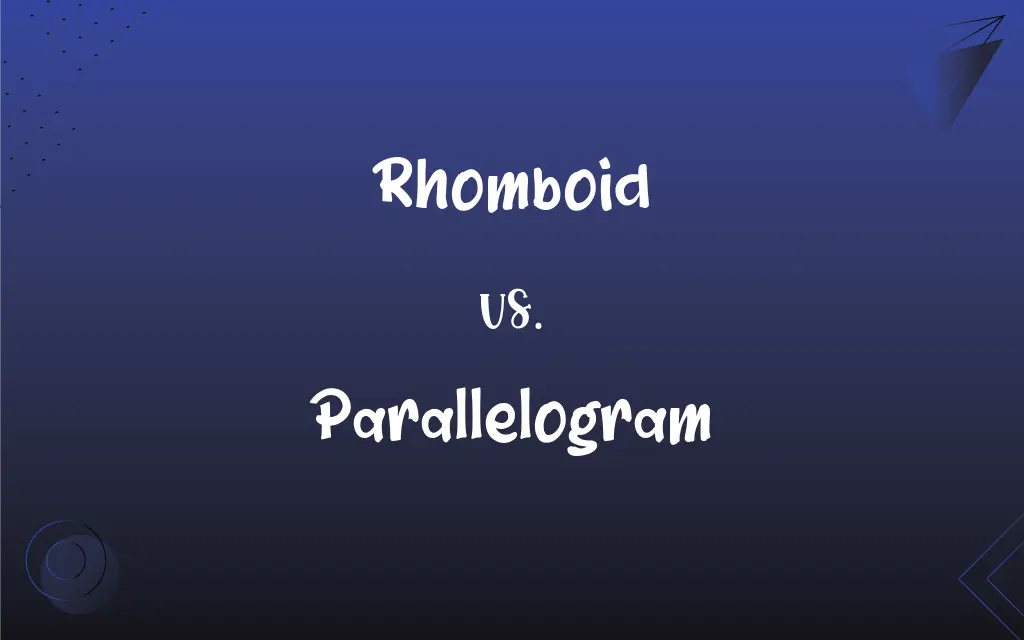Rhomboid vs. Parallelogram: What's the Difference?
Edited by Janet White || By Harlon Moss || Updated on November 3, 2023
A rhomboid is a quadrilateral with opposite sides parallel and adjacent sides unequal, while a parallelogram has opposite sides parallel and equal.

Key Differences
A rhomboid is a type of quadrilateral whose opposite sides are parallel to each other but adjacent sides are of unequal lengths and angles between sides are not 90 degrees. In a rhomboid, opposite angles are equal, and adjacent angles are supplementary.
A parallelogram is a more general geometric term for a four-sided figure with two pairs of parallel sides. In a parallelogram, opposite sides are not only parallel but are also equal in length, and opposite angles are equal. This makes every rhomboid a parallelogram, but not all parallelograms are rhomboids.
The term rhomboid often refers to a slanted parallelogram, one that does not contain right angles, unlike rectangles which are also a type of parallelogram. Rhomboids can resemble a stretched diamond shape, which is actually called a rhombus - a special kind of parallelogram with all sides equal.
Parallelograms include a variety of shapes including rectangles, rhombuses, and rhomboids. The defining feature is their parallel opposing sides. The internal angles of a parallelogram adjust to maintain the parallel structure, which means the angles can be obtuse or acute, but always in pairs.
While both rhomboids and parallelograms have sides opposite to each other that are parallel, the lengths and angles can differ. Rhomboids focus on the parallel aspect without the requirement of equal-length sides, whereas parallelograms have the additional characteristic of equal-length opposite sides.
ADVERTISEMENT
Comparison Chart
Sides
Opposite sides parallel, adjacent unequal
Opposite sides parallel and equal
Angles
Opposite angles equal, adjacent supplementary
Opposite angles equal, angles are supplementary
Special Cases
Does not have right angles
Can have right angles (rectangles)
Symmetry
Has point symmetry
Has translational and reflective symmetry
Definition Specificity
More specific than parallelogram
More general term
ADVERTISEMENT
Rhomboid and Parallelogram Definitions
Rhomboid
A parallelogram with adjacent sides of unequal lengths.
The artist drew a perfect rhomboid for the painting’s background.
Parallelogram
A shape applicable to various figures like rectangles and rhombuses.
This figure is not just a square; it’s a type of parallelogram.
Rhomboid
In anatomy, a muscle resembling a rhomboid shape.
His workout routine included exercises to strengthen the rhomboid muscles.
Parallelogram
In physics, a force diagram that shows vector addition.
We used a parallelogram to represent the forces acting on the object.
Rhomboid
A quadrilateral with no right angles and unequal sides.
The children made a kite in the shape of a rhomboid.
Parallelogram
A four-sided figure with opposite sides parallel and equal.
In class, we learned how to calculate the area of a parallelogram.
Rhomboid
A geometric shape with opposite sides parallel but not equal.
She noticed the rhomboid pattern on the tile floor.
Parallelogram
Any quadrilateral that can be divided into two congruent triangles.
A parallelogram can be split into two congruent triangles by a diagonal.
Rhomboid
Anything diamond-shaped but with unequal sides.
The rhomboid window gave the room an unusual light.
Parallelogram
A shape often used in tiling and patterns due to its tessellation properties.
The artist used a parallelogram motif in the mosaic design.
Rhomboid
A parallelogram with unequal adjacent sides, especially one having oblique angles.
Parallelogram
A four-sided plane figure with opposite sides parallel.
Rhomboid
Shaped like a rhombus or rhomboid.
Parallelogram
(geometry) A convex quadrilateral in which each pair of opposite edges are parallel and of equal length.
Parallelogram
Either of two rectangular areas (respectively the large parallelogram and the small parallelogram) abutting the goal line in front of the goal. (Since 1986 officially named the large rectangle and small rectangle, though the older names are still occasionally used.)
Parallelogram
A right-lined quadrilateral figure, whose opposite sides are parallel, and consequently equal; - sometimes restricted in popular usage to a rectangle, or quadrilateral figure which is longer than it is broad, and with right angles.
Parallelogram
A quadrilateral whose opposite sides are both parallel and equal in length
FAQs
What distinguishes a parallelogram from a rectangle?
A rectangle has right angles; a general parallelogram does not necessarily have them.
Is every rhomboid a parallelogram?
Yes, every rhomboid is a parallelogram.
Can a rhomboid have right angles?
No, if a rhomboid had right angles, it would be a rectangle.
Are the diagonals of a parallelogram equal?
Not always, unless it’s a rectangle or a square.
What makes a rhomboid different from a rhombus?
A rhombus has all sides of equal length, while a rhomboid does not.
Are all parallelograms rhomboids?
No, not all parallelograms are rhomboids.
Is a square considered a parallelogram?
Yes, a square is a specific type of parallelogram with all sides equal and all angles right angles.
How many axes of symmetry does a parallelogram have?
A general parallelogram has no axes of symmetry unless it’s a rectangle or a square.
Are the diagonals of a rhomboid equal?
No, the diagonals of a rhomboid are not equal.
How many axes of symmetry does a rhomboid have?
A rhomboid typically has one axis of symmetry.
Can you tile a floor with rhomboids without gaps?
Yes, rhomboids can tessellate to cover a plane without gaps.
Is it possible to tile a floor with parallelograms?
Yes, parallelograms can also tessellate to cover a plane without gaps.
Does a rhomboid have equal angles?
Only the opposite angles are equal in a rhomboid.
Are the opposite sides of a rhomboid always parallel?
Yes, that's a defining property of a rhomboid.
Do all parallelograms have opposite angles that are equal?
Yes, that is true for all parallelograms.
What are the properties of a parallelogram's sides?
A parallelogram has opposite sides that are both parallel and equal in length.
Can a rhomboid have congruent diagonals?
No, that property belongs to rectangles and squares.
In which field is the term rhomboid often used?
It's often used in geometry and anatomy.
Where is the term parallelogram commonly used?
Mostly in geometry and physics.
What are the properties of a rhomboid's sides?
A rhomboid has opposite sides that are parallel and unequal adjacent sides.
About Author
Written by
Harlon MossHarlon is a seasoned quality moderator and accomplished content writer for Difference Wiki. An alumnus of the prestigious University of California, he earned his degree in Computer Science. Leveraging his academic background, Harlon brings a meticulous and informed perspective to his work, ensuring content accuracy and excellence.
Edited by
Janet WhiteJanet White has been an esteemed writer and blogger for Difference Wiki. Holding a Master's degree in Science and Medical Journalism from the prestigious Boston University, she has consistently demonstrated her expertise and passion for her field. When she's not immersed in her work, Janet relishes her time exercising, delving into a good book, and cherishing moments with friends and family.































































